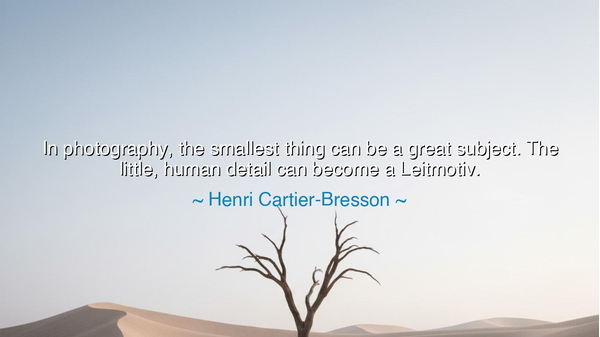
In photography, the smallest thing can be a great subject. The
In photography, the smallest thing can be a great subject. The little, human detail can become a Leitmotiv.






“In photography, the smallest thing can be a great subject. The little, human detail can become a Leitmotiv.” Thus spoke Henri Cartier-Bresson, the master of the decisive moment, whose camera did not merely capture images but revealed the soul of life itself. His words are not confined to the art of photography alone—they are a meditation on existence, a call to see the extraordinary hidden within the ordinary. In this saying, he reminds us that greatness does not always reside in grand landscapes or monumental gestures, but in the quiet poetry of a glance, a shadow, a wrinkle, or a hand at rest. The smallest thing, when seen with love and attention, becomes infinite.
Cartier-Bresson lived through the restless pulse of the twentieth century—wars, revolutions, awakenings—and yet he was never drawn to spectacle for its own sake. Instead, he turned his lens to the details of humanity: a child’s laughter in the ruins of war, a man leaping over a puddle, a couple’s embrace reflected in a mirror. These moments, fleeting and fragile, became eternal through his vision. When he speaks of the Leitmotiv, a term from music meaning the recurring theme that unites a symphony, he teaches that every artist—and indeed, every soul—can find meaning in repetition, in the small patterns that form the rhythm of life.
In this way, his quote stands not only as a lesson for photographers, but for all seekers of truth. The ancients, too, knew that divinity hides in the details. The Stoics taught that one must attend to each moment with presence and reverence, for the texture of a single instant contains the whole of life. The Zen masters of the East, centuries before the invention of the camera, sought enlightenment in the smallest acts—pouring tea, sweeping a floor, hearing a bird cry at dawn. Cartier-Bresson, though armed with a Leica instead of a brush or a prayer, was guided by the same wisdom: to see with clarity is to live with awareness.
Consider the story of Johannes Vermeer, the Dutch painter who lived two centuries before photography’s birth. His works, too, were filled with the smallest details—a woman reading a letter, a beam of sunlight spilling upon a tiled floor, the quiet balance between shadow and reflection. He painted not kings or battles, but moments so delicate that they seemed to tremble between existence and eternity. Like Cartier-Bresson, Vermeer understood that the sacred is found in the everyday, and that true art is not the magnification of life, but the revelation of what already dwells within it.
Cartier-Bresson’s words also speak to the spiritual discipline of observation. In a world that rushes toward the spectacular, the wise soul learns to pause. To look deeply is an act of reverence; to notice the smallest thing is to affirm that nothing is too insignificant to matter. The wrinkled face of an elder, the way sunlight falls upon cobblestones, the brief meeting of eyes between strangers—these are the true stories of humanity. To witness them with humility is to understand that beauty is not a possession, but a presence—a moment recognized and honored before it vanishes.
And yet, there is something heroic in this quiet seeing. For in attending to the little things, we resist the numbness of habit and the blindness of distraction. The photographer, the poet, the thinker—all must cultivate patience, that noble virtue of those who wait for meaning to reveal itself. The smallest gesture—a smile, a trembling hand, a sigh—may contain more truth than all the proclamations of kings. In learning to see such things, one learns to understand others, and in understanding others, one learns to understand oneself.
From this quote, let us draw a lesson for our own lives: seek depth, not spectacle. Let your attention be a sacred lens, your compassion the light that reveals the hidden beauty in all things. When you walk, do not only move through space—observe. When you speak, do not only make sound—listen. When you love, do not only desire—notice. The great art of living, like the great art of photography, lies not in accumulation but in perception.
Thus, as Henri Cartier-Bresson teaches, the world’s grandeur lies not in its size, but in its detail. Every gesture, every fleeting second, is a note in the music of existence. To see it, to honor it, is to join the eternal symphony of life. The smallest thing—a hand brushing against another, a droplet of rain on glass, a forgotten smile—can become the Leitmotiv of your own story, the recurring theme that binds your heart to the mystery of all things. For the one who truly sees, nothing is ever small, and nothing is ever lost.






AAdministratorAdministrator
Welcome, honored guests. Please leave a comment, we will respond soon